It is no secret that we, as modern humans, have extremely deviated from our natural diet. To the extent that we don’t know what the natural human diet looks like – the diet that is specific to our species in nature! The question “What diet have we evolved to eat?” is actually a pressing issue in today’s contradictory dietary jungle. Luckily, our anatomy and physiological adaptations to diet don’t lie and offer a reliable compass.
The species-specific diet and health
For every animal species in nature, we can observe a specific diet – the species-appropriate diet. We often forget that humans also have a species’ natural diet. What foods are “biologically appropriate” for us is based on the evolutionary concept that we have developed specializations and adaptations to forage and digest specific foods over time while others we cannot.
The species-specific diet is biologically best suitable for the human body – and, therefore, the healthiest diet there can be! The foods of the biologically appropriate diet provide the organism with the nutrition it needs and do not overly stress the digestive, detoxification, or elimination system. The toxic burden is at a minimum. Considering these benefits, a valid question arises: Why is studying the evolutionary diet of humans not gaining more attention in nutritional science?
Most of us eat foods all day long that are not suitable for humans! However, deviating too far from our human species-appropriate diet causes chronic health conditions because we are feeding our body the “wrong” food composition. Foods are basically a highly complex “chemical mixture” that the organism has to process to extract nutrition and excrete what is not needed. Depending on the food sources of our ancestors, we are more or less well adapted to biochemically process a particular food.
Species-specific diets are well-known to anyone who feeds or observes animals, like animal caretakers, biologists, or pet owners. Wrong feeding causes disease in animals… and humans. Dobzhansky’s famous “Nothing in Biology Makes Sense Except in the Light of Evolution” includes foods and nutrition:
Also, in nutrition, nothing makes sense except in the light of evolution! Human ancestors have evolved as frugivores in tropical forests, and we still carry their adaptations related to diet.
It seems, however, that we have forgotten about this natural principle for our own species, due to cultural reasons. We even seem to have forgotten what our own species’ diet is. It’s essential, however, to re-discover what is supposed to be in our instincts: learn what we should eat naturally by understanding foods and learning from our closest relatives, the chimpanzees!
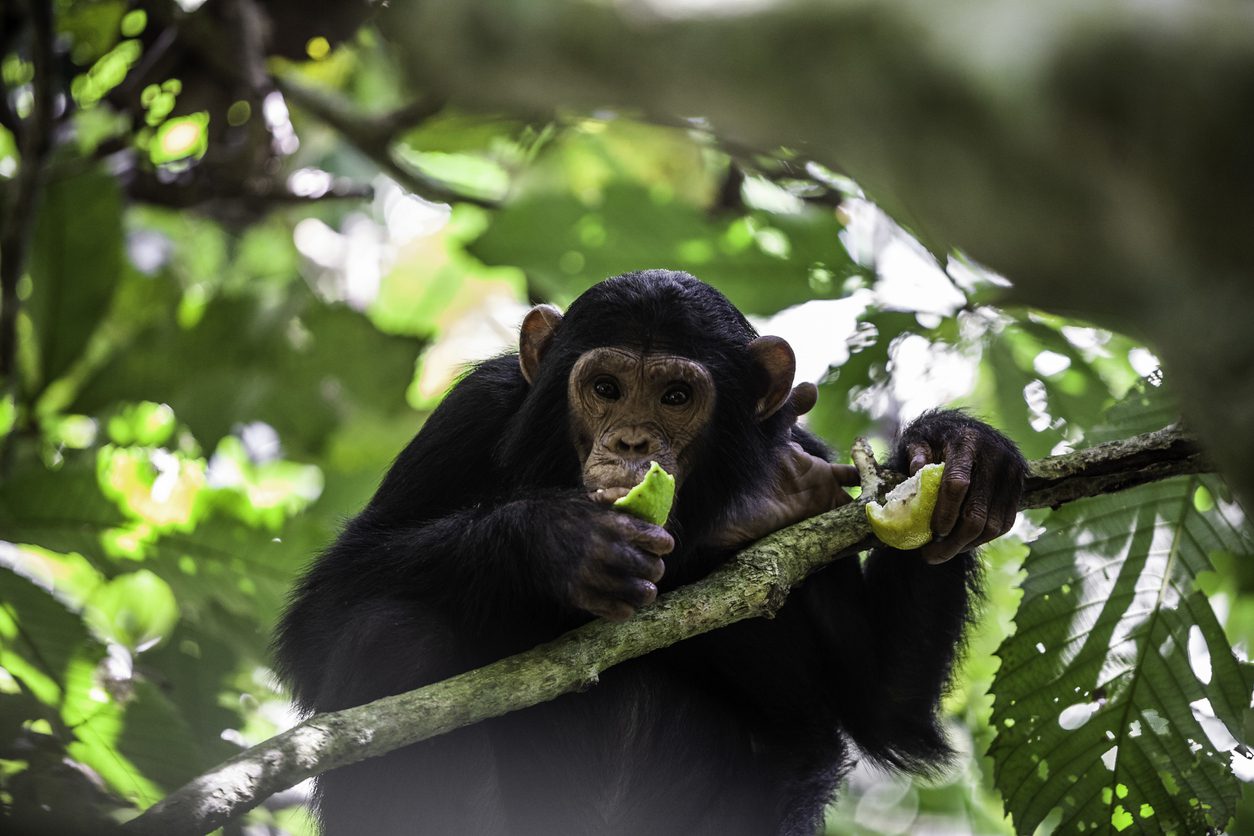
How can we study the human evolutionary diet?
Determining the specific-specific (or biologically appropriate) diet of humans is more complicated than in other species. Why? Humans left their original tropical habitat, tropical forests, with the help of sophisticated cultural adaptations, including altering food sources through cooking. Those skills prevented evolutionary adaptations to a new environment and foods to a large extent.
There are two approaches to investigating our evolutionary diet. One is studying hunting-gathering humans before agriculture, and one is comparing humans to our closest living relatives, the chimpanzees, and their diet – which is a frugivorous diet!
1. Hunter-gatherers: Paleolithic Diet
The most popular evolutionary diet is the paleolithic diet, or “a hunter-gatherer” diet. The diet of our recent ancestors before they settled and introduced new foods by agriculture and cultivation. The foods they ate were determined by local conditions and available foods. Therefore, there are different types of paleolithic diets.
There are two major issues with the hunter-gatherer diet: firstly, paleoanthropology is one of the most uncertain disciplines in biology and, thus, a highly controversial field. Secondly, the hunter-gatherer is a survival diet. It is not the diet we have evolved to eat. Human ancestors evolved in tropical forests with a diet based on fruits. Basically, hunting was the survival strategy outside our natural habitat – and meat and cooked foods were (and still are) our fallback foods. We adapted mainly by using tools and fire.
This is the reason why the paleolithic dietary concept is hardly backed up with biological traits and dietary adaptations related to foods, foraging, digestion, and metabolism. For example, humans have not evolved with a cooked diet; we have only adapted with a slightly higher tolerance towards cooked foods, with a decreased immune response, but cooked foods still trigger our immune system, unlike raw foods. We are thus not “cookivores” that are hooked to a cooked diet. Read more about cooked foods and our earliest ancestors’ diet here.

The modern interpretation of a paleolithic diet is basically omnivorous, including (cooked and raw) vegetables, fruits, greens, meat, eggs, nuts, and seeds. The diet often does have significant health benefits, as it is a significant improvement on an average diet. Leaving out grains and processed foods is a huge step towards better health, but is it really the ultimate evolutionary diet?
2. Apes: Frugivore Diet
Another way to study the diet type of a species is by using comparative anatomy and physiology – comparing adaptations related to diet. Diet- and foraging-related traits like digestion, teeth, hands, taste receptors, or biochemical characteristics are compared to closely related species, in our case, primates. In anatomy, the function of a structure or a trait can be predicted by its form. Thus, shared traits in evolution indicate similar dietary ecology. And because we can observe the diets of those species in the wild, we can learn about our own natural diet.
Humans share many striking adaptations specific for frugivores with their primate family, especially apes, which are all highly frugivorous.
Chimpanzees are humans’ closest living relatives – and they are specialized ripe fruit-eaters found in tropical habitats. Humans also originated in the tropics and is still a tropical species (Daanen et al., 2016).
So what’s the Chimpanzees’ diet like?
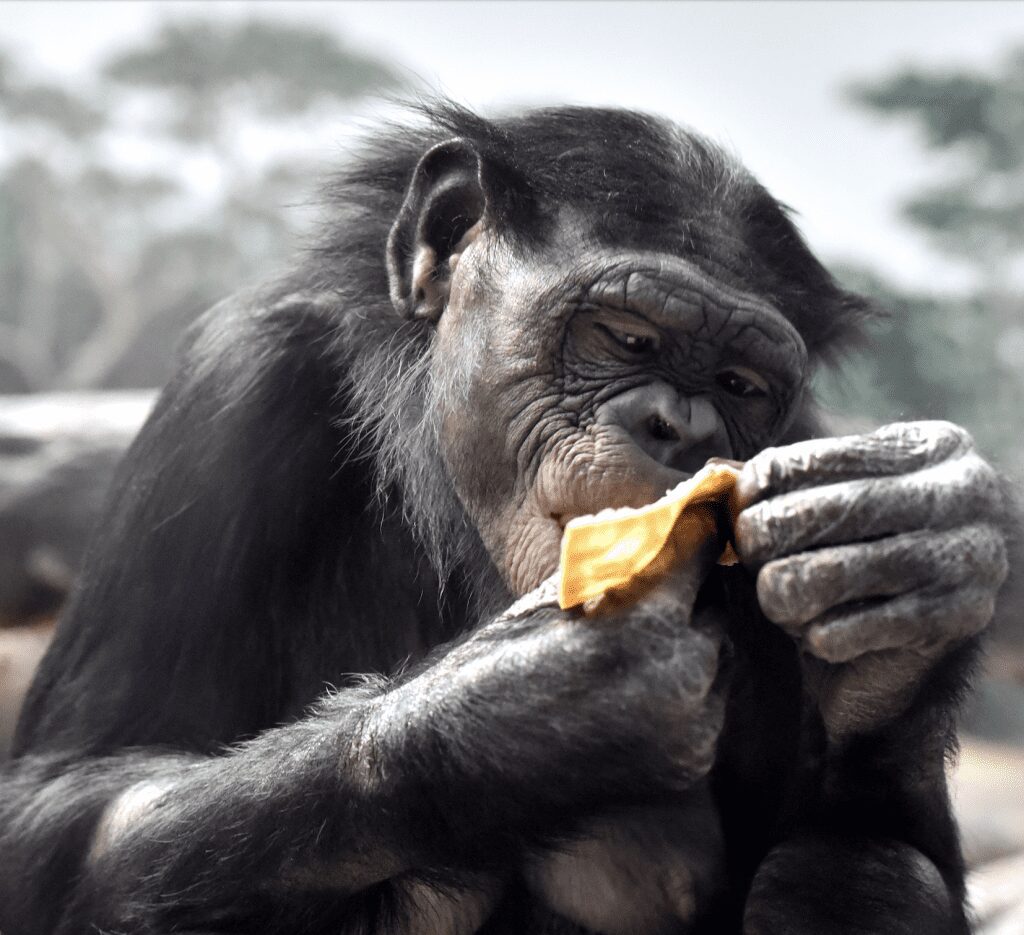
Chimpanzees mainly eat tropical fruits (around 70%), but also greens, nuts, bark, flowers, and some animal foods like insects, eggs, and sometimes meat. So, frugivores mainly forage for fruits, but they do consume other food types in much smaller amounts.
Adaptations in humans that are typical for frugivorous primates
What traits specialize frugivores in a high-fruit species and diet? Humans and Chimpanzees share intriguing features with each other that serve essential functions in fruit foraging. They also share many features with other frugivorous mammals, which are not as closely related. The same diet can lead to the same adaptations in species of different evolutionary lineages independently (analogous traits).
List of some of the most remarkable biological features that have evolved with our dietary habits as highly frugivorous species:
- Loss of internal vitamin C synthesis due to high fruit intake, a characteristic specific for frugivorous animals.
- Trichromatic color-vision: specialized color-vision for highly effective fruit foraging.
- Digestive anatomy and microbiome like other frugivorous primates.
- Dentition typical for frugivorous primates
- Complex hand with opposable thumbs needed for tree life and fruit foraging.
- Tasting sweetness. While we love sweet – not all animals can even taste it!
- Instincts: sensory cues strongly attract us to ripe fruits (color, smell, taste), unlike any other food in nature.
- Humans originated in the tropics: tropical forests are the only habitat that sustains larger frugivores.
Find an in-depth article on these traits here and an article on what dietary adaptations can tell us generally, here.
A major difference of the primate frugivorous diet compared to the Paleolithic dietary concept is not only the much smaller proportion of meat, but also that there is no cooking! Everything is raw – straight from nature. Here is where instinctual knowledge becomes a thing:
3. Human Instincts
Instincts are a natural intelligence innate to all living organisms, to either be attracted to, or repelled by a specific food. Thus, our instincts are an underrated tool to help us study our species-appropriate diet: Natural dietary behavior (i.e., in children) or our own taste receptors, and visual and olfactory cues can give us important information on what we would actually eat.
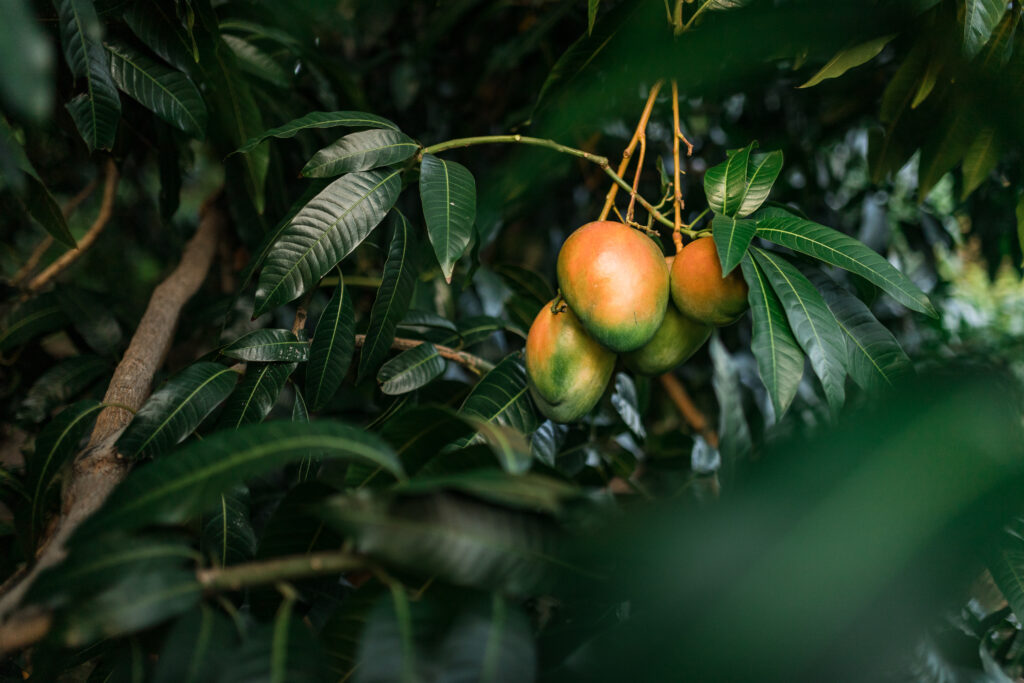
Simple questions related to our own instincts and behaviors can aid to identify the human species-appropriate diet: in what environment could humans live without infrastructure and food processing? In other words: to what conditions are we adapted biologically? What foods can we eat straight from nature? Animals obviously know what to eat in the wild by using their instincts. Try feeding an impala fresh meat and a lion fruits…
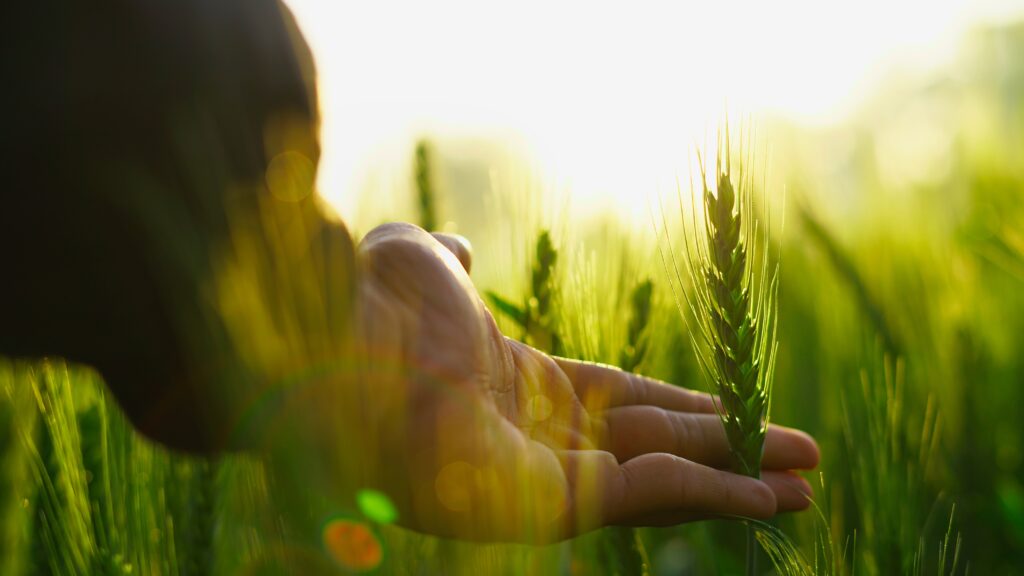
Grains are an example of what we eat today that is not really human food: Grains are not something we would consider food in the wild! It does not look or taste appealing. Most grains need to be processed and cooked to be edible! Grain-eaters (granivores) like insects and birds are adapted to grains and their toxic defense chemicals plants release to protect their progeny. We are not. Now, we call them “anti-nutrients“.
We can ask these questions about any other food: For example, would we eat raw meat straight from nature? And would we find it appealing? Or rather see this as a “second choice” type of food? Would we eat beans, roots, kale, or insects? Some foods would not be our preferred food, but they serve as fallback food. But some foods we eat today are highly toxic when raw! Read more on suitable food groups for humans here.
Aren’t humans clearly classified as omnivores?
Yes, humans are classified as omnivores because we are able to digest both, plants and animal-based foods.
However, humans do have distinct adaptations as specialized fruit-eaters like our closest living relatives, all great apes, and many other frugivorous primates, which are classified as frugivorous omnivores. Therefore it would be worth a discussion to specify the human dietary classification and refer to humans as frugivorous omnivores, too. What might seem like detail is essential in shaping the perception of our natural diet!
Should we be learning from chimpanzees or hunter-gatherers?
This question does not have a clear-cut answer because we do not live in our natural environment. We might should be learning from both! The takeaway message is that humans share a lot of adaptations and instincts with chimpanzees in terms of diet, which should no longer be ignored. A diet high in tropical fruits seems a good idea, in either case!
From real-life experience, both diets can improve health, as many inflammatory foods are left out in both of them! However, there are levels to health, and the health-improvement reports of people going on the frugivore diet seem to far outperform the paleo experience. However, a frugivore diet demands that we live in a tropical, natural environment in the long run!
There are some apparent drawbacks to studying the paleolithic diet! While studying our direct ancestors is fascinating, it is clearly limited, as we look into a widely unknown past. Also, the paleolithic diet does not take into account that cultural adaptation does not equal biological adaptation, which is essential to the understanding of our natural habitat and diet. Thus, comparative evolutionary analysis has many advantages in this sense and also allows for real-life observations and experiments.
Adaptive traits in anatomy and physiology related to diet, reveal the dietary ecology of a species – including humans. Thus, by studying our characteristics for foraging we can discover a lot about the natural human diet.
We find that humans share many fascinating traits with their closely related frugivorous (fruit-eating) ape and primate family. Comparing the diets and traits of wild chimpanzees certainly deserves more attention when studying the species-appropriate nutrition of humans.
Combining both approaches by studying the here and now, plus understanding human adaptations to colder climates and their more recent food sources (i.e., cooked food tolerance, fire smoke toxins, and lactose tolerance) can be valuable when we do not have abundant access to the foods needed for a tropical frugivore diet! We might have to consider integrating the best-possible fallback foods into our diet, when our natural foods are limited!
Know what you are doing when adopting our natural diet!
References
- Paleolithic diet. Wikipedia (2023) (available at https://en.wikipedia.org/wiki/Paleolithic_diet).
- D. J. Bergman, Fraud and forgery in paleoanthropology. Answers in Genesis (2009) (available at https://answersresearchjournal.org/fraud-and-forgery-in-paleoanthropology/).
- R. Lewin, “Chain of Fraud” – Bones of contention (available at https://www2.clarku.edu/faculty/djoyce/piltdown/map_expose/chain_of_fraud.html). (1987)
- H. A. M. Daanen, W. D. Van Marken Lichtenbelt, Human whole body cold adaptation. Temperature. 3, 104–118 (2016), doi:10.1080/23328940.2015.1135688.
- K. Milton, Nutritional characteristics of wild primate foods: Do the diets of our closest living relatives have lessons for us? Nutrition. 15, 488–498 (1999), doi:10.1016/s0899-9007(99)00078-7.
- Adaptation. Education (available at https://education.nationalgeographic.org/resource/adaptation/).
- Y. Tu, W.-J. Rappel, Adaptation in living systems. Annual Review of Condensed Matter Physics. 9, 183–205 (2018), doi:10.1146/annurev-conmatphys-033117-054046.
- N. Stewart, Smoke signals: DNA adaptation helped early humans deal with toxic fumes. The Guardian (2016) (available at https://www.theguardian.com/science/2016/aug/02/smoke-signals-dna-adaptation-helped-early-humans-deal-with-toxic-fumes).


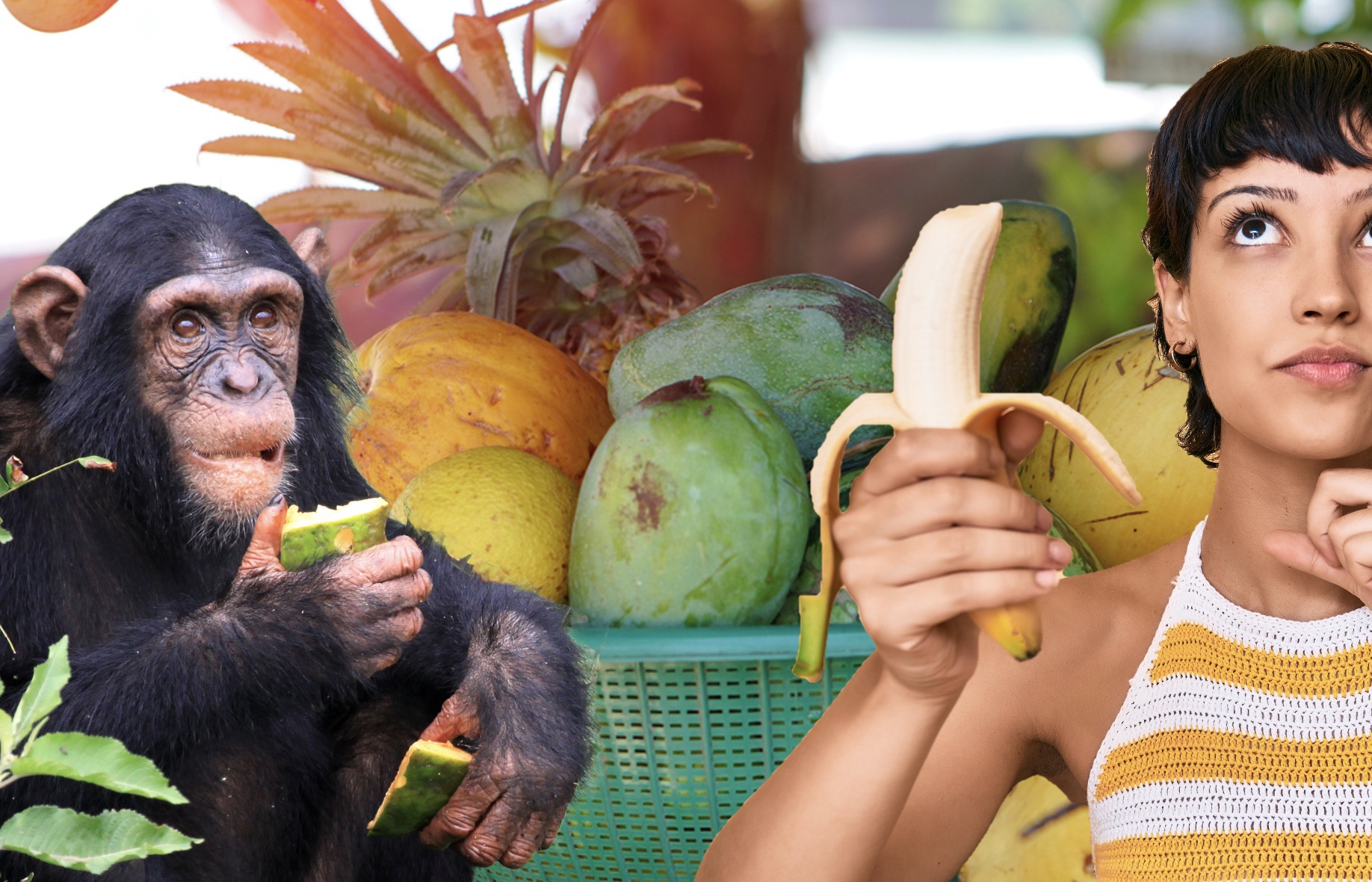
Hallo,
” However, a frugivore diet demands that we live in a tropical, natural environment in the long run! “……
Does this mean that if you live in Switzerland (I live in Austria) in a colder climate, it will not be healthy for us to eat only raw fruit and a bunch of green salads?
Hi Emilia, thanks for reaching out. I would say that it is not impossible, but it is certainly challenging and depends on your access to tropical foods. This is why most people on a long-term fruit-based diet move to the tropics. In cold climates, we lack of abundant access to a variety of high-quality ripe tropical fruits, which are the basis of a frugivore’s diet. We also do not have the benefits of warmer climates and sunshine. If you have ever lived in tropical areas, you can feel the difference and will be stunned by the fruits. In my opinion, the best solution is to get as many tropical fruits as you can, maybe also check out Asian and Indian stores, frozen tropical fruits like acai berries and good quality bananas, and tropical raw nuts, and eat greens.
Also, consider the supplements needed in cold climates, like B12, vitamin D, and, for most of us, iodine and selenium, which you can supplement with Brazil nuts and sea moss. If you feel you are lacking or losing weight, you can look into the raw-til-4 approach or just occasionally add a warm meal. We can always do detox periods of fruit-only or strictly raw. We just do the best we can, right?
What’s your experience with a fruit-based diet in cold climates?
I have a very small selection of tropical fruits here and most of them are unripe. the longest I lasted was only fruit, vegetables and some buckwheat bread in the winter for only 4 months. But after such a diet, my triglycerides and HbA1c increased a lot.
I keep coming back to moderate consumption of meat, especially in winter. I feel warmer after meat. I tried to warm myself with ginger, but after it I get gastritis.
Hey Emilia, thanks for your comments!
If you feel like meat helps you, but you don’t really want to eat it, try to see if it might be due to low iron (it could very well be related to feeling cold). If you do a ferritin check and you are low (under 100), you can easily get a liquid herbal or plant-based product to help you raise it.
Unfortunately, this is the problem of living outside our natural habitat and not having access to our species’ original foods. This is why our ancestors had to adopt meat-heavy diets (and later dairy and grains) in the first place. But if you prefer to stay plant-based and leave out many unhealthy foods, you might look into a plant-based paleo diet during winter. If you strive to stay raw, even without having good access to tropical fruits, you might look into the raw diet or a raw vegan diet that includes more tubers, nuts, and sprouted foods.
I am planning to write more about being a frugivore (we all are) in cold climates. But frankly, the struggle is real, and sometimes we just need to balance our fallback foods.
Thank you for your response.